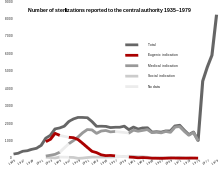Compulsory sterilisation in Sweden

Forced sterilisation in Sweden (Swedish: Tvångssterilisering i Sverige) occurred between 1934 and 1975. It was never legal to physically restrain the patient. Between 1973 and 2012 sterilisation was a condition for sex change.
Originally the aim of the sterilisation policy was to protect society and it targeted the so-called feeble-minded or other individuals who were considered unfit. This practice peaked in the mid 1940s. In 1944 85 % of the sterilisations were performed on eugenic grounds. From the 1950s and onwards the law came to be used mostly in the interest of the individual, for social or medical reasons, under varying degrees of pressure from doctors and social workers.[4]
According to the 2000 governmental report, 21,000 were estimated to have been forcibly sterilised, 6,000 were coerced into a 'voluntary' sterilisation while the nature of a further 4,000 cases could not be determined.[5] The Swedish state subsequently paid out damages to victims who contacted the authorities and asked for compensation.
There were three indications for sterilisation:[6]
- Medical if a pregnancy could seriously put a woman suffering from chronic illness or permanently weakened constitution at risk of life and health.
- Eugenic indication meant sterilisation could be done if a person's offspring would receive undesired genes for insanity, severe illness or physical handicap of other kind.
- Social indication allowed sterilisation for someone evidently unsuitable to foster a child due to mental illness, being feebleminded or other distortion of the psyche, or having an asocial lifestyle.
In 1922 the State Institute of Racial Biology was founded in Uppsala. In the 1930s, a law legitimized forced sterilization of thousands.[7] Another law, passed in 1941, was more far reaching, included a social indication and did not include any age of consent limit.
From 1944, the number of eugenic sterilizations under the 1941 legal provisions gradually decreased.
In Sweden, sterilization was only mandatory before sex change.[8] This last mandatory sterilization has been criticized by several political parties in Sweden and since 2011 the Parliament of Sweden was expected to change the law but ran into opposition from the Christian Democrat party. After efforts to overturn the law failed in parliament, the Stockholm Administrative Court of Appeal overturned the law Dec. 19, declaring it unconstitutional[9][10] after the law was challenged by an unidentified plaintiff.
See also
References
- ↑ Tydén, Mattias (2002). Från politik till praktik: de svenska steriliseringslagarna 1935-1975. Stockholm studies in history, 0491-0842 ; 63 (in Swedish) (2., utvidgade uppl. ed.). Stockholm: Almqvist & Wiksell International. ISBN 91-22-01958-8.
- ↑ Allmän hälso- och sjukvård [Elektronisk resurs] (in Swedish). Stockholm. 1913–1982.
- ↑ 1997 års steriliseringsutredning (2000), Steriliseringsfrågan i Sverige 1935-1975 [Elektronisk resurs] : historisk belysning, kartläggning, intervjuer : slutbetänkande, Statens offentliga utredningar, 0375-250X ; 2000:20 (in Swedish), Stockholm: Fritzes offentliga publikationer, p. 156
- ↑ Tydén, Mattias (2002). Från politik till praktik: de svenska steriliseringslagarna 1935-1975. Stockholm studies in history, 0491-0842 ; 63 (in Swedish) (2., utvidgade uppl. ed.). Stockholm: Almqvist & Wiksell International. p. 584. ISBN 91-22-01958-8.
- ↑ Steriliseringsfrågan i Sverige 1935 - 1975, SOU 2000:20, in Swedish with an English summary.
- ↑ page 30 Steriliseringsfrågan i Sverige 1935 - 1975, SOU 2000:20, in Swedish with an English summary.
- ↑ Maria Björkman, Sven Widmalm (2010). "Selling eugenics: the case of Sweden". Notes & Records. doi:10.1098/rsnr.2010.0009.
- ↑ Sweden keeps sex-change sterilization law, The Local, January 12, 2012
- ↑ Nelson, Rebecca. "Transgender People in Sweden No Longer Face Forced Sterilization". Time. ISSN 0040-781X. Retrieved 2016-09-01.
- ↑ "Good News For Sweden's Transgender Residents". The Huffington Post. 2013-01-14. Retrieved 2016-09-01.